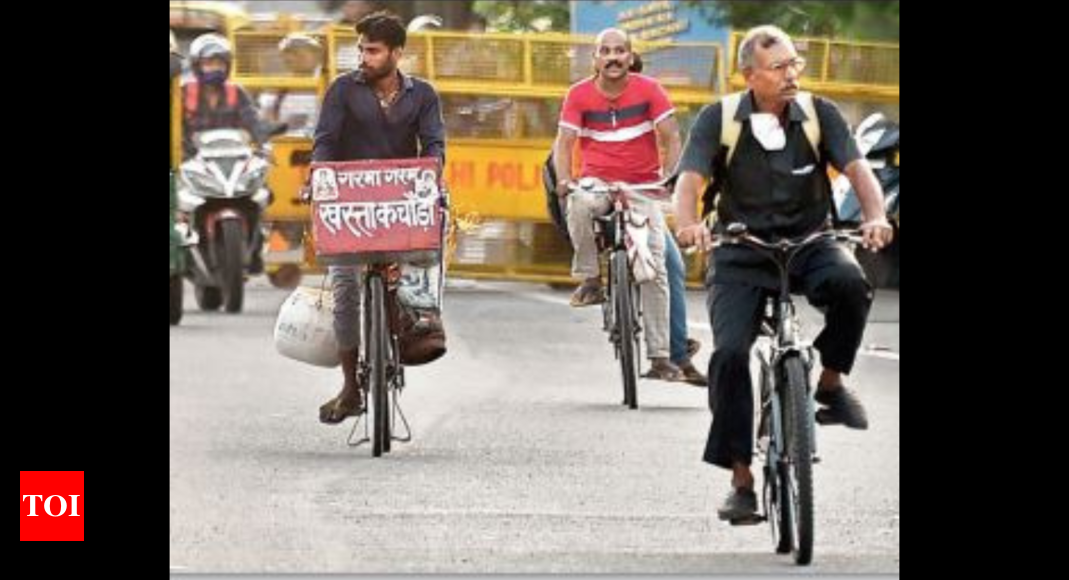NEW DELHI: Have bicycle lanes just become an element of road beautification rather than properly engineered routes? According to cyclists and experts, this is indeed the case, with the roads not yet safe for people using bicycles. Most of the Public Works Department’s streetscaping and lane-demarcation projects involve marking cycle lanes on the roads only for them to vanish after a short distance leaving the cyclists among the rush of motorists. “The biggest problem is that there are no end-to-end safe cycle routes,” noted Amit Bhatt, managing director, International Council on Clean Transportation. “The segregated lanes on the roads are not enough. The traffic also needs to slow down to allow cyclists to co-exist on the road with the motorists.” While Delhi government has been making efforts to promote bicycles for sports, tourism and leisure, the two-wheeler has a long way to go in becoming a reliable mode of transport. Cyclists in the city have to fend for themselves because of the lack of suitable road infrastructure such as dedicated cycle paths. According to the European Cyclists’ Federation, a non-profit organisation, 44% of train commuters in the Netherlands use a bicycle to reach the train station. The group said in a report that in European cities like Amsterdam and Hague, up to 70% of all journeys are made on bicycles. In these countries, cycle paths are clearly marked, have smooth surfaces, separate signage and lights and are wide enough to allow side-by-side cycling and overtaking. “Dedicated cycle lanes are the most neglected part of the road infrastructure in the capital, but the other cities are no different,” said Vivek Chattopadhyay, principal programme manager (clean air and sustainable mobility), Centre for Science and Environment. “The car-centric development is only leading to construction of flyovers, which disrupt cycling. Also there is a problem of cycle lanes just for the sake of beautification, which is happening now. No proper engineering parameters are being employed for this.” According to CSE, a cycle track is imperative at locations where the usage of bicycles is high among daily-wage workers and where schools and offices are sited. “In such places, traffic-calming measures to slow down the motorists for the safety of cyclists are also necessary,” added Chattopadhyay. Cycling enthusiast Jitender Jassal of Saket welcomed the steps taken to specify bus lanes, but merely marking a cycle track did not diminish the risks faced by Delhi’s cyclists. “People use bicycles both for sports and transportation. Policymakers have to keep many factors in mind, such as effecting a change in mindset to being more considerate about all road users,” said Jassal. “More cycle lanes are being created, yes, but they are not properly maintained. Many have been encroached. Motorised two wheelers also get on these tracks, forcing cyclists onto the main roads.” Since the pandemic began, people are extra concerned about their health, which led to many of them taking to cycling. Jassal claimed there were around 30 cycling groups, each with 50-100 members, in Delhi. There are innumerable others who haven’t joined cycling clubs. To add to these are the tens of thousands of people who cycle to their workplaces. Approximately 11 lakh people in Delhi commute daily on bicycles. “There is no lengthy cycle lane in the city at the moment,” said a PWD official. The pilot project we are undertaking near the Britannia Chowk flyover jointly with IIT, Delhi, and Delhi government’s transport department aims at separate lanes for cycles and motor cars and this could be extended to many other places. Yes, proper maintenance of cycle lanes is an issue. But we, as engineers, can only create the infrastructure. It is then up to the civic bodies to enforce discipline, maintain cycle tracks and prevent encroachment.” A reality check at the Britannia Chowk flyover showed the cycle lane marked in white at the narrow end of the road in front of bus queue shelter and then proceeding for a short distance before ending abruptly. Similarly, the specified bicycle lane along the dismantled BRT corridor in south Delhi disappears along the way, leaving cyclists at the mercy of the heavy traffic on the segment. In December 2019, Union home minister Amit Shah laid the foundation stone for a mega cycle walk across the city being created by Delhi Development Authority at a cost of Rs 550 crore. It is expected to be completed next year. DDA’s ambitious project involves a cycling ring in the city connecting metro stations, bus stands, business and educational hubs and industrial, recreational, high-density residential areas. Of the total, nearly 7km of the track will be elevated. In Phase 1 of the project, 36km of cycling and walking tracks will be developed in Tughlaqabad, Sangam Vihar, Saket, Greater Kailash, Sant Nagar and the adjoining localities of south Delhi. It will pass through Delhi Master Plan green-forest areas. In the NDMC area, the project began at Lodhi Garden to facilitate the movement of people towards the park. But here too, TOI found that after the initial craze, now autorickshaws are parked on the safeguarded lane during the day, an augury perhaps of what awaits the cyclists.
Source: https://timesofindia.indiatimes.com/city/delhi/whose-lane-is-it-anyway-why-cyclists-in-delhi-find-selves-in-no-mans-land/articleshow/93717328.cms

